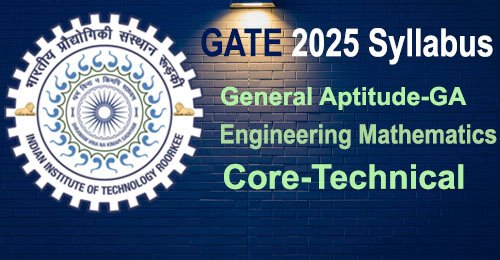GATE 2025 CS Computer Science & Information Technology-CSE Syllabus
Important Note for Candidates: In each of the following subjects the topics have been divided into two categories – Core Topics and Special Topics. The corresponding sections of the question paper will contain 90% of their questions on Core Topics and the remaining 10% on Special Topics.
Section 1: General Aptitude (GA) Syllabus
(Common for all, 10 Question, 15 Marks)
The General Aptitude section is a common component across all papers of the GATE 2025 examination, constituting 15 marks out of 100 for each subject. The syllabus, available on the official website, aids candidates in preparing more effectively for the GATE 2025 exam. The GATE General Aptitude (GA) Syllabus comprises four key sections:
- 1. Quantitative Aptitude
- 2. Verbal Aptitude
- 3. Analytical Aptitude
- 4. Spatial Aptitude
1. Quantitative Aptitude in the General Aptitude (GA) Syllabus covers the following topics:
- Numerical computation and estimation
- Ratios
- Percentages
- Powers
- Exponents and logarithms
- Permutations and combinations
- Series
- Mensuration and Geometry
- Elementary statistics
- Probability
2. Verbal Aptitude in General Aptitude (GA) Syllabus includes the following topics:
| Basic English Grammar | Basic Vocabulary |
|---|---|
| Tenses | Words |
| Articles | Idioms and phrases |
| Prepositions | |
| Conjunctions | |
| Adjectives | |
| Verb-Noun agreement |
3. Analytical Aptitude in the General Aptitude (GA) Syllabus includes the following topics:
- • Logic: deduction and induction
- • Analogy
- • Numerical relations and reasoning
4. Spatial Aptitude in the General Aptitude (GA) Syllabus includes the following topics:
- • Transformation of shapes
- • Translation & Rotation
- • Scaling & Mirroring
- • Assembling & Grouping
- • Cutting & Paper folding pattern
- • Patterns in 2 and 3 dimensions
Section 2A: Engineering Mathematics
Discrete Mathematics: Propositional and first-order logic. Sets, relations, functions, partial orders, and lattices. Monoids, Groups. Graphs: connectivity, matching, coloring. Combinatorics: counting, recurrence relations, generating functions.
Linear Algebra: Matrices, determinants, system of linear equations, eigenvalues and eigenvectors, LU decomposition.
Calculus: Limits, continuity, and differentiability. Maxima and minima. Mean value theorem. Integration.
Probability and Statistics: Random variables. Uniform, normal, exponential, Poisson, and binomial distributions. Mean, median, mode, and standard deviation. Conditional probability and Bayes theorem.
Section 2B: Computer Science & Information Technology Core Subjects
Subject-1: Digital Logic
Boolean algebra. Combinational and sequential circuits. Minimization. Number representations and computer arithmetic (fixed and floating point).
Subject-2: Computer Organization and Architecture
Machine instructions and addressing modes. ALU, data‐path and control unit. Instruction pipelining, pipeline hazards. Memory hierarchy: cache, main memory and secondary storage; I/O interface (interrupt and DMA mode).
Subject-3: Programming and Data Structures
Programming in C. Recursion. Arrays, stacks, queues, linked lists, trees, binary search trees, binary heaps, graphs.
Subject-4: Algorithms
Searching, sorting, hashing. Asymptotic worst case time and space complexity. Algorithm design techniques: greedy, dynamic programming and divide‐and‐conquer. Graph traversals, minimum spanning trees, shortest paths
Subject-5: Theory of Computation
Regular expressions and finite automata. Context-free grammars and push-down automata. Regular and contex-free languages, pumping lemma. Turing machines and undecidability.
Subject-6: Compiler Design
Lexical analysis, parsing, syntax-directed translation. Runtime environments. Intermediate code generation. Local optimisation, Data flow analyses: constant propagation, liveness analysis, common sub expression elimination.
Subject-7: Operating System
System calls, processes, threads, inter‐process communication, concurrency and synchronization. Deadlock. CPU and I/O scheduling. Memory management and virtual memory. File systems.
Subject-8: Databases
ER‐model. Relational model: relational algebra, tuple calculus, SQL. Integrity constraints, normal forms. File organization, indexing (e.g., B and B+ trees). Transactions and concurrency control.
Subject-9: Computer Networks
Concept of layering: OSI and TCP/IP Protocol Stacks; Basics of packet, circuit and virtual circuit-switching; Data link layer: framing, error detection, Medium Access Control, Ethernet bridging; Routing protocols: shortest path, flooding, distance vector and link state routing; Fragmentation and IP addressing, IPv4, CIDR notation, Basics of IP support protocols (ARP, DHCP, ICMP), Network Address Translation (NAT); Transport layer: flow control and congestion control, UDP, TCP, sockets; Application layer protocols: DNS, SMTP, HTTP, FTP, Email.


